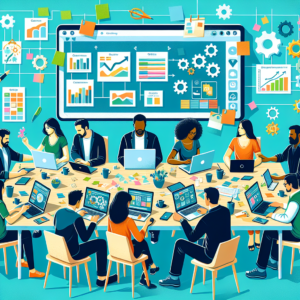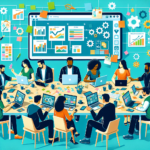Large-Scale Retrospectives: Techniques for Continuous Improvement
In the ever-evolving world of Agile and Scrum, retrospectives are the cornerstone of continuous improvement. But, how do you efficiently conduct these retrospectives at a large scale? Let’s dive into some techniques to ensure your large-scale retrospectives are as impactful as they are insightful. 🚀
Table of Contents
1. Why Retrospectives Matter
2. Scaling Up the Retrospective
3. Techniques for Large-Scale Retrospectives
4. Common Challenges and Solutions
5. Conclusion
6. FAQ
Why Retrospectives Matter
Retrospectives are more than just a routine meeting; they’re a valuable opportunity for teams to reflect on successes, identify challenges, and chart a course for improvement. When done right, retrospectives foster a culture of openness, learning, and collaboration. But as teams grow, so do the complexities of running these sessions effectively.
Scaling Up the Retrospective
When dealing with large teams or multiple teams, scaling retrospectives requires a strategic approach. Here are some tips to keep in mind:
1. Break It Down: Split large groups into smaller, more manageable teams. This allows for more in-depth discussions and ensures everyone’s voice is heard.
2. Use Digital Tools: Leverage collaborative tools like Miro or Trello to facilitate virtual retrospectives, especially for distributed teams. These platforms can help gather feedback and insights in real time.
3. Set a Clear Agenda: Having a well-defined agenda helps keep the session focused and productive. Ensure each segment has a purpose and time limit.
Techniques for Large-Scale Retrospectives
Here are some tried-and-tested techniques to enhance your large-scale retrospectives:
Fishbowl Conversations 🐟: This technique involves a small group of people having a conversation in a “fishbowl” while others observe. It encourages active listening and can surface diverse perspectives without overwhelming the conversation.
World Café ☕: This method involves breaking the group into small, diverse discussion tables. Participants rotate between tables, allowing ideas to cross-pollinate and evolve.
Lean Coffee ☕: A structured but agenda-less meeting. Participants propose topics, vote on them, and discuss based on priority. This technique is excellent for large groups as it focuses on what’s most relevant to the attendees.
Common Challenges and Solutions
Conducting large-scale retrospectives comes with its own set of challenges. Here are some common ones and how to tackle them:
Challenge: Ensuring Participation from All
Solution: Use anonymous feedback tools to allow everyone to contribute without fear. Encourage quieter team members to share their thoughts using digital platforms.
Challenge: Managing Time Effectively ⏰
Solution: Stick to the agenda. Assign a facilitator to keep discussions on track and ensure that each section of the retrospective is given the appropriate focus.
Challenge: Keeping Engagement High 🎯
Solution: Incorporate interactive elements and varied activities to maintain interest. Rotate facilitators to bring fresh perspectives to each session.
Conclusion
Large-scale retrospectives don’t have to be daunting. With the right techniques and tools, they can become a powerful mechanism for fostering continuous improvement and building a cohesive team. Embrace the challenge, and watch your team grow stronger and more collaborative. 🌟
FAQ
Q1: How often should large-scale retrospectives be conducted?
A: Ideally, they should be held at the end of each sprint or project phase, but the frequency can be adjusted based on your team’s needs and feedback.
Q2: What if some team members are reluctant to share feedback?
A: Encourage a safe and open environment. Use anonymous tools to allow everyone to share their insights without hesitation.
Q3: Can retrospectives be effective in remote settings?
A: Absolutely! With the right digital tools and a structured approach, virtual retrospectives can be just as effective as in-person ones.
Q4: How do I measure the success of a retrospective?
A: Success can be gauged by the actionable outcomes generated, team engagement levels, and the implementation of agreed-upon improvements.
Q5: What role does a facilitator play in a large-scale retrospective?
A: The facilitator guides the session, ensures the agenda is followed, and fosters an environment where all participants feel comfortable contributing.













